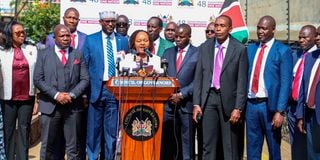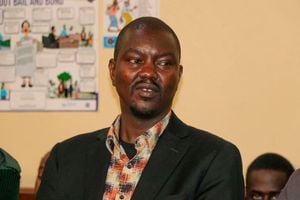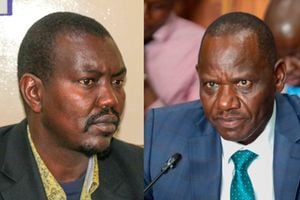
Council of Governors chairperson Anne Waiguru (centre) with her colleagues during a past media briefing in Nairobi.
The evolution and history of the Roman Empire remains an interesting study of leadership. About 2,000 years ago, this was a global superpower and its influence in the modern world remain. Our democracy, our religions — they all find their rooting in the Roman Empire.
One of the pre-eminent leaders was Julius Ceasar. After his assassination, the empire went into a period of turmoil before the emergence of Augustus Ceasar, also known as Octivan. He is reputed to be the best Roman ruler on account of presiding over prolonged period of development and peace. Unlike Julius Ceaser, he deftly applied power.
Julius Ceasar was the opposite — he exercised power in a naked and direct manner — attracting many enemies and leading to his assassination.
On his deathbed, Augustus is reputed to have stated, "I found Rome a City of bricks and left it a city of marbles." His statement captures the notion that leadership should be about transformation.
Today, let us not trumpet the good side of the coin but rather highlight the challenges of managing a county.
Financial management
And the first challenge remains the financial management. The revenue side of the budget will capture projections. They include money sent from national government (equitable share), own source revenue and various grants. Then there is the expenditure side.
The law provides at least 30 per cent of counties budgets should go to development. Provision of school feeding programme, purchase of drugs and bursaries are not development but recurrent. These Public Sector Accounting Standards are constraining.
Often, counties do not get projected revenues from national government despite this having been set out by express laws. For example, County X may be set to receive Sh10bn but actually gets Sh9bn.The equitable share sent to counties is usually divided on equal monthly disbursement. Last tranches are sometimes sent to counties one day before end of a financial year. Practically that means counties cannot spend the money. Own source revenue presents an acute dilemma. An increment of counties taxes exposes governors to accusations of overtaxation. But failure to hit own source revenue targets causes budgets to underperform.
Pending bills
Unrealised county revenues, whether as a result of low own source of revenue or delayed exchequer releases, makes actual budget to negate counties development and plan. It is the major cause of pending bills since counties commitments exceed real budget items.
And this gap between budget estimates and actual budget creates another challenge: Human resource management. The most important factor of any production is labour. The Public Finance Management Act provides salaries should not exceed 35 per cent of county budgets. I am not aware of any county that has adhered to this provision.
The budget of Murang’a County for salaries is 45 per cent. Some might argue counties should downsize. But, there are humanitarian concerns of sacking employees who have families. Also, often counties have huge human resource deficits. Murang’a County government, for instance, has a 5,000 workforce serving one million residents. Early childhood Development and Education teachers are 1,000 serving 42,000 learners. It has 230 clinical officers serving one million residents.
But when it comes to actual budget, the salaries component percentage skyrockets to 53 per cent (amount actually spent by counties due to budget underperformance). This attracts constant audit queries in the Senate.
Higher perks
Various employee cadres agitate for higher perks and for good reason. Employees will always seek higher salaries to beat inflation. But an expansion of salaries payments further aggravates flouting of the 35 per cent cap. National government policies also aggravate the problem.
The best remedy for this is to increase own source revenue while ensuring counties do not increase taxes. Best way to achieve this is through automation. For instance, Murang’a County is on course to hit the Sh1bn mark notwithstanding its county taxes were last raised in 2018. But automation has its own problems. Installation cost is prohibitive plus frequent downtime that disrupts services. Internet connection in Murang’a has been frequently disrupted for the last one month for reasons beyond our control. Noting the 157 public health facilities are now almost fully automated, the disruptions have been devastating.
Rewarding efforts of employees through motivational schemes also helps to enhance labour relationships.
The third challenge of counties management remains the choice of developmental programmes.
The developmental journey differs from county to county. Various interests conflict in that choice. How to create a neat balance between water, health, infrastructure and energy deficits demands for constant studying and analysis. Our healthcare programme was copied from the United Kingdom in 1945 under 1945 Clement Atlee’s Labour government. The Smart City programme was inspired by what Kakamega Governor Wycliffe Oparanya and his Laikipia counterpart Ndiritu Muriithi did during their terms. But of course there are local innovations like Inua Mkulima e voucher Programme..
Daunting task
Finally, political management of counties remains a daunting task. All governments have people always plotting how to topple them. In autocracies, that plotting takes a violent form.
In democracies, that plotting takes a more benign form of agitation and social media fights. How to keep political nobles happy – the assembly, the bourgeoisie, senator and MPs— while also keeping the ordinary masses happy requires tact and hard work. There is no known common formula. Today things can be normal only for a sudden destruction. One lives a day at a time.
The problem becomes more aggravated when one takes into account National politics fissures like the ongoing rumble in the mountain. Governors are at a loss on what to do. As leaders fight between "One man, one vote, one shilling" versus " One man, one kilometre, one shilling, " county leaders can only pray for "One God, one aim one destiny."
Dr Kangata is the Governor of Murang’a County; Email [email protected]










